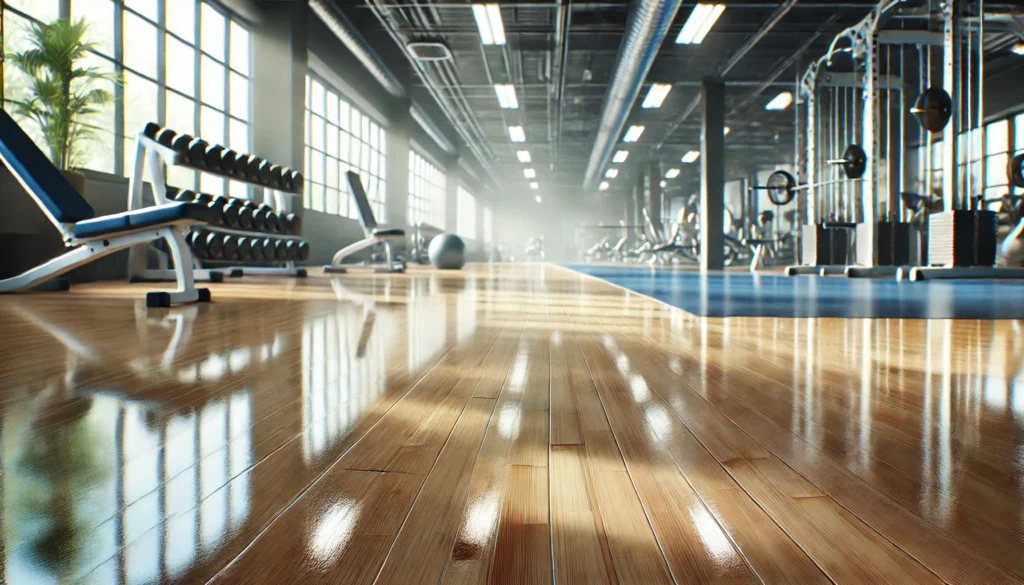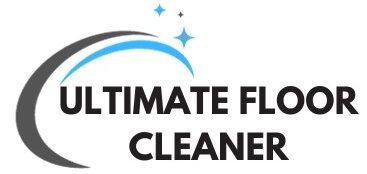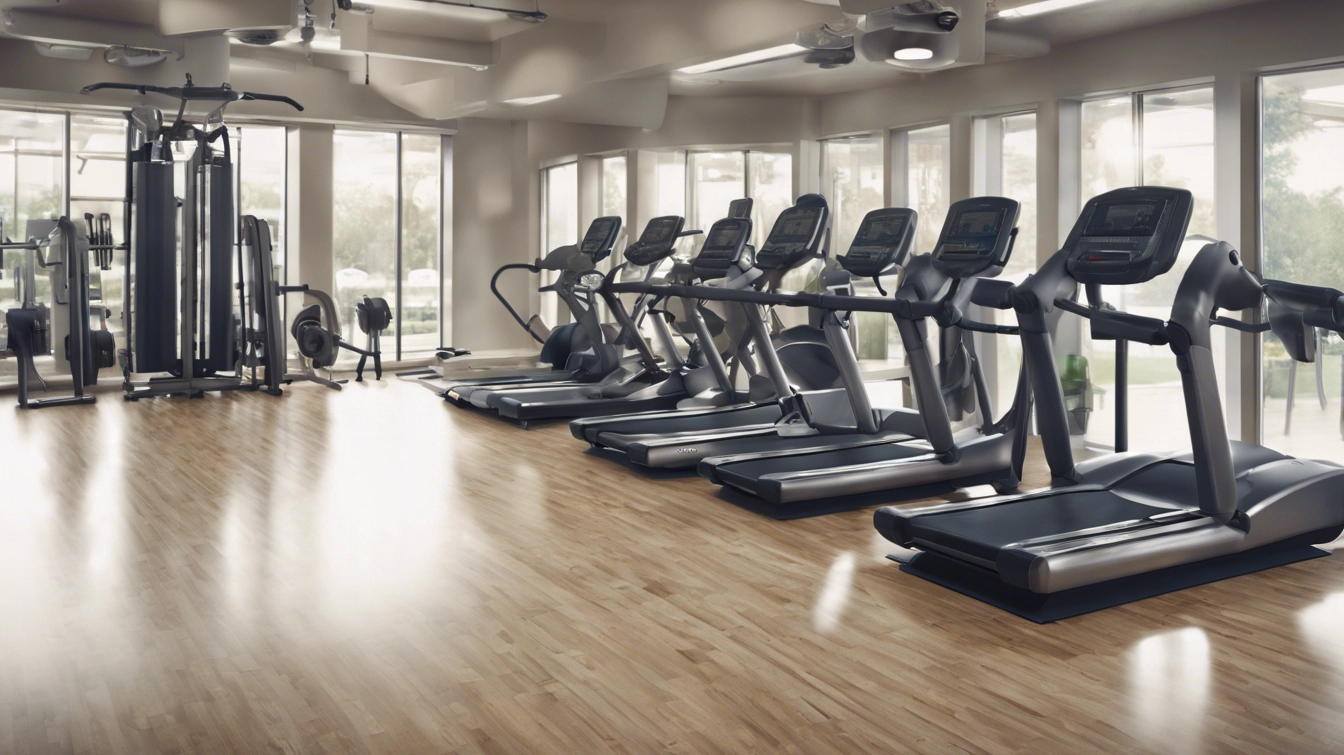Maintaining a clean gym floor is not just about aesthetics; it’s crucial for the safety, hygiene, and overall experience of everyone using the facility. Whether you’re managing a commercial gym, a school sports hall, or your own home workout space, keeping the floor clean ensures a healthier environment, prolongs the lifespan of the flooring material, and prevents potential accidents from slips or contamination.
In this guide, we’ll walk you through everything you need to know about how to clean a gym floor, focusing on various types of flooring materials commonly found in gyms. From rubber to hardwood, each surface requires specific care and cleaning techniques to maintain its integrity and appearance. By the end of this guide, you’ll be equipped with the knowledge to keep your gym floor spotless and safe for all users.
Step-by-Step Instructions
Step 1: Identify Your Gym Floor Type
Before you start cleaning, it’s essential to know what type of flooring you’re dealing with. Gym floors can be made from various materials, each with unique cleaning requirements.
- Rubber Flooring: Common in weight rooms and functional training areas due to its durability and shock-absorbing properties.
- Hardwood Flooring: Typically found in basketball courts and multi-use sports halls, known for its smooth surface and professional appearance.
- Vinyl or PVC Flooring: Often used in commercial gyms due to its resilience and ease of maintenance.
- Carpet Tiles: Less common but used in some fitness centers for specific workout zones like yoga or stretching areas.
Why This Matters: Different flooring materials react differently to cleaning agents and methods. Using the wrong approach could damage the floor or leave it less safe for gym users.

Step 2: Gather Your Cleaning Supplies
Once you’ve identified the floor type, gather the appropriate cleaning supplies. Here’s what you’ll need for each type:
For Rubber Flooring:
- pH-neutral cleaner
- Warm water
- Mop or soft-bristle broom
- Vacuum cleaner
- Microfiber cloths
- Disinfectant (optional)
For Hardwood Flooring:
- Hardwood floor cleaner (ensure it’s safe for gym floors)
- Soft, dry mop
- Damp mop (only if necessary)
- Buffing pads (for polishing)
For Vinyl or PVC Flooring:
- Mild detergent or a vinyl-specific cleaner
- Warm water
- Mop with a microfiber head
- Soft-bristle brush (for stubborn stains)
For Carpet Tiles:
- Carpet cleaner (enzyme-based for removing odors)
- Vacuum cleaner with a beater bar
- Spot cleaner for stains
- Dehumidifier (optional, for drying)
Tip: Always use products that are specifically designed for the type of flooring you have. This prevents any potential damage and ensures the best results.
Step 3: Remove Loose Debris
Before any deep cleaning can begin, the first step is to remove any loose debris from the floor. This includes dirt, dust, and any other particles that could scratch or damage the surface when mopping.
Rubber Flooring:
- Vacuum the floor: Use a vacuum cleaner with a brush attachment to pick up loose dirt and debris. Ensure you cover the entire area, including corners and edges.
- Sweep with a soft-bristle broom: For any areas that the vacuum missed, use a broom to sweep away the remaining debris.
Hardwood Flooring:
- Dust mop: Use a dry, soft mop to gently sweep across the floor. This removes dust without scratching the surface.
- Vacuum corners and edges: If your floor has gaps or edges where dust collects, use a vacuum cleaner to remove it.
Vinyl or PVC Flooring:
- Sweep the floor: A soft-bristle broom works best here to avoid scratching the surface.
- Vacuum: Go over the entire floor with a vacuum to pick up fine dust and debris.
Carpet Tiles:
- Vacuum thoroughly: Use a vacuum with a beater bar to agitate the carpet fibers and lift dirt.
- Spot check for debris: Ensure no small items or debris are left that could interfere with the cleaning process.
Why This Step is Crucial: Removing debris prevents it from being spread around during mopping, which could lead to scratches or ineffective cleaning.
Step 4: Apply the Cleaning Solution
Now that your floor is free from loose debris, it’s time to apply the cleaning solution. This step varies slightly depending on the type of flooring.
Rubber Flooring:
- Mix a pH-neutral cleaner with water: Follow the manufacturer’s instructions for the correct ratio.
- Mop the floor: Use a damp mop to apply the solution, working in small sections. Avoid soaking the floor, as excess water can seep into seams.
- Scrub stubborn areas: If there are spots with heavy grime or sweat stains, use a soft-bristle brush to gently scrub these areas.
- Rinse with clean water: Mop again with clean water to remove any residue.
Hardwood Flooring:
- Spray a small section with hardwood cleaner: Apply the cleaner directly to the floor in a fine mist.
- Wipe with a dry mop: Immediately follow with a dry mop to clean the area. Never let liquid sit on hardwood floors.
- Buff if necessary: If the floor looks dull after cleaning, use a buffing pad to restore its shine.
Vinyl or PVC Flooring:
- Dilute the cleaner in water: Mix according to the instructions on the label.
- Mop the floor: Work in sections, ensuring the mop is damp but not wet.
- Scrub tough spots: Use a soft-bristle brush for any stubborn dirt.
- Rinse with clean water: Finish by mopping with clean water to remove any leftover cleaning solution.
Carpet Tiles:
- Apply carpet cleaner: Spray the cleaner onto the carpet, focusing on high-traffic areas.
- Scrub with a brush: Use a carpet brush to work the cleaner into the fibers.
- Vacuum the area: After the cleaner has dried, vacuum to remove any residues.
- Use a spot cleaner: For specific stains, apply a spot cleaner and blot with a clean cloth.
Key Tip: Always follow the manufacturer’s instructions for both the flooring and the cleaning products. This ensures the longevity of your gym floor.
Step 5: Disinfecting (Optional but Recommended)
In high-traffic gyms, it’s essential to regularly disinfect the floor to maintain a hygienic environment.
Rubber Flooring:
- Dilute a disinfectant: Choose a product safe for rubber floors and dilute it as recommended.
- Apply with a mop: Use a damp mop to apply the disinfectant evenly across the floor. Allow it to air dry.
Hardwood Flooring:
- Spray lightly: Use a hardwood-safe disinfectant spray. Apply sparingly and wipe immediately.
- Avoid overuse: Disinfecting too often can damage the wood, so limit this to once a week or after spills.
Vinyl or PVC Flooring:
- Mop with disinfectant: Apply a diluted disinfectant solution with a mop. Ensure the floor is not left too wet.
- Air dry: Allow the floor to air dry completely before use.
Carpet Tiles:
- Use an enzyme cleaner: For areas with sweat or other biological stains, an enzyme cleaner works best.
- Vacuum after drying: Once the disinfectant has done its job, vacuum the area to restore the carpet fibers.
Why Disinfection Matters: Regular disinfection prevents the spread of bacteria and viruses, creating a safer workout environment.
Step 6: Final Inspection and Drying
After cleaning and disinfecting, it’s essential to inspect the floor and ensure it’s completely dry before allowing any activity.
- Check for missed spots: Walk around the entire area and look for any spots you may have missed. Reclean if necessary.
- Dry the floor: If there are still damp areas, use fans or dehumidifiers to speed up the drying process.
- Final sweep: For carpeted areas, do a final vacuum to lift the fibers and remove any leftover debris.
Safety Tip: Ensure the floor is fully dry before use to prevent slips and falls.
Troubleshooting and Tips
Even with the best practices, you might encounter some challenges when cleaning gym floors. Here’s how to troubleshoot common issues:
Stubborn Stains on Rubber Floors
- Solution: Use a stronger concentration of pH-neutral cleaner or a specialized rubber floor stain remover. Scrub with a soft-bristle brush and rinse thoroughly.
Dull Hardwood Floors
- Solution: If your hardwood floor looks dull after cleaning, it may need a light buffing. Use a soft buffing pad or consider a professional polish to restore the shine.
Sticky Residue on Vinyl Flooring
- Solution: This usually happens if too much cleaner was used. Mop again with clean water to remove the residue.
Persistent Odors in Carpet Tiles
- Solution: Use an enzyme-based cleaner designed to break down the sources of odors. Ensure the area is well-ventilated and dry thoroughly.
Tips for Success:
- Regular Maintenance: Don’t wait for the floor to look dirty. Regular cleaning prevents the buildup of grime and extends the life of your gym floor.
- Use the Right Tools: Investing in quality mops, vacuums, and cleaning solutions makes the job easier and more effective.
- Educate Users: Encourage gym-goers to clean up after themselves and report spills immediately to prevent damage.
Related Posts:
How to Clean Rubber Gym Floors: The Ultimate Guide
Conclusion
Cleaning a gym floor might seem straightforward, but doing it correctly is crucial for maintaining a safe and welcoming environment. By following the steps outlined in this guide, you can ensure that your gym floor remains in top condition, whether it’s rubber, hardwood, vinyl, or carpet. Regular maintenance not only keeps the floor looking great but also extends its lifespan, saving you time and money in the long run.
Remember, the key is consistency. Regular cleaning and disinfection are essential to keeping the gym environment safe and healthy for all users. Now that you’re equipped with the knowledge of how to clean a gym floor effectively, it’s time to put these tips into action.
Ready to put your new skills to the test? Start your cleaning routine today and see the difference it makes in your gym’s appearance and safety. If you have any more questions or need further assistance, feel free to explore more of our resources.
By following this guide, you’ll not only maintain a clean gym floor but also ensure a healthier, safer, and more inviting space for all gym-goers.
FAQs About How to clean gym floor mats
1. How often should I clean my gym floor?
It depends on the usage, but a general rule is to clean high-traffic areas daily and do a more thorough cleaning weekly. For less-used areas, twice a week may suffice.
2. Can I use bleach on rubber gym floors?
It’s not recommended. Bleach can damage rubber over time. Instead, use a pH-neutral cleaner or a product specifically designed for rubber flooring.
3. What’s the best way to clean hardwood gym floors?
Use a hardwood-safe cleaner and a soft mop. Avoid excess water, and always dry mop afterward to prevent water damage.
4. How do I remove sweat stains from gym floors?
For rubber or vinyl, a mild detergent usually works. For carpets, an enzyme cleaner is best. Always follow up with a disinfectant.
5. Is it necessary to disinfect the gym floor?
Yes, especially in high-traffic areas or after spills. Regular disinfection helps prevent the spread of germs and keeps the gym safe.
6. How to clean gym floor mats?
Cleaning gym floor mats is essential to maintain hygiene and extend their lifespan. Here are some steps to help you clean them effectively:
1. Remove Loose Dirt and Debris: Start by vacuuming or sweeping the mats to get rid of any loose dirt, dust, or debris.
2. Spot Cleaning: For any stains or sticky spots, use a mild detergent mixed with water. Apply the solution to the affected area and scrub gently with a soft brush.
3. Mopping: Use a mop with a neutral pH cleaner and always avoid using harsh chemicals as they can damage the mats. Mop the entire surface to ensure thorough cleaning.
4. Deep Cleaning: For a more thorough clean, especially in commercial gyms, use an auto-scrubber with a neutral cleaning solution. This helps to remove embedded dirt and sweat.
5. Drying: Allow the mats to air dry completely before using them again so that this can prevent mold and mildew growth.
6. Regular Maintenance: Keep disinfectant wipes or spray handy to quickly clean the mats after each use. This helps maintain cleanliness between deep cleans.
7. How to make gym floor less slippery
Making a gym floor less slippery is crucial for safety and performance. Here are some effective methods:
1. Regular Cleaning: Dust and dirt can make floors slippery. Use a microfiber dust mop daily to remove loose debris.
2. Use Stronger Cleaning Products: Sometimes mild cleaners aren’t enough. Use a strong, gym-specific cleaner to remove sweat, oils, and other residues.
3. Anti-Slip Coatings: Apply an anti-slip coating to the floor. These coatings increase traction and reduce slipperiness.
4. Proper Maintenance: Avoid using too many different cleaners, as they can leave residues that make the floor slippery. Stick to a consistent cleaning routine.
5. Humidity Control: High humidity can make floors slippery. Use dehumidifiers to maintain optimal humidity levels in the gym.
6. Floor Mats: Place non-slip mats in high-traffic areas to provide extra traction.
7. Refinishing: If the floor is worn out, consider getting it refinished to restore its original texture and grip.

